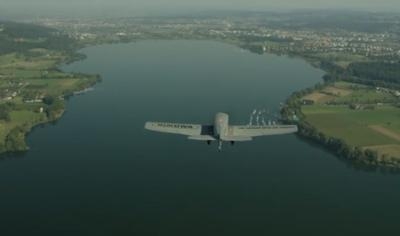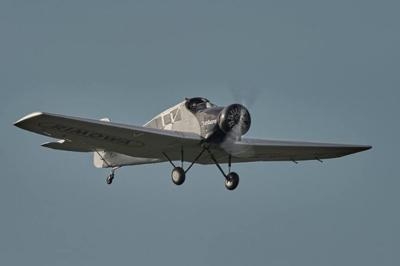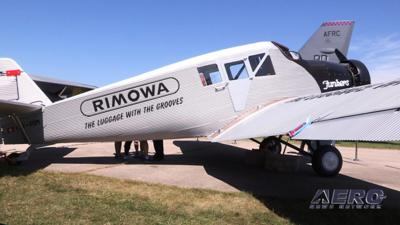Luggage Company Rimowa Has Sponsored The Effort
A project to bring back the Junkers F13 reached a significant milestone September 15th, 2016. The official first flight of the replica took place in Dübendorf, Switzerland, almost 100 years after the launch of the ‘mother of all commercial aircraft’. With the take-off, what was constructed under the project name ‘Rimowa F13’ became a veritable Junkers F13 ... extending the legacy of the visionary professor Hugo Junkers.

The aircraft stood elegantly on Dübendorf airfield, formerly Zurich’s primary airport. Spectators had travelled from all over the world in honor of the ‘Annelise 2’ – so named as a nod to one of the first Junkers F13 planes.
The aircraft gently started to taxi, gathered pace and smoothly lifted off in just over 650 feet. Its engine delivers 450 hp and a cruising speed of 95 knots. Screens on the airfield displayed live images from the cockpit. While the replica features significantly more technical equipment than the cockpit of an original Junkers F13, it does not compare with modern jets as they have glass cockpits.
Like the original 100 years ago, the Junkers F13 conveys the same sense of freedom. The open cockpit was occupied by test pilot Oliver Bachmann, along with Rimowa President & CEO Dieter Morszeck, who has been a private pilot himself for 34 years. An additional camera was trained on the test pilot’s skilful manual actions as he confidently navigated the aircraft. The landing was then executed with as much applause as the take-off. The Junkers F13 touched down smoothly and was met with sustained applause. “This is a dream come true for me," said Morszeck after the flight. "The Junkers F13 is back in the air and I was fortunate enough to experience its official first flight as a member of the crew! What more could I ask for?”
The Junkers F13 was the world’s first all-metal commercial aircraft, serving as a source of inspiration for generations of aircraft manufacturers and blazing a trail in modern-day passenger aviation. The original, achieved an altitude record of 22,145 feet on September 13th, 1919, which was an incredible feat at the time.

There were seven years of research, planning and approvals between the initial idea and the aircraft’s maiden flight. Three strong partners joined forces in order to manage a project of this scale: JU-AIR, the Association of Friends of Historical Aircraft (VFL) and Rimowa. The aircraft was commissioned by the German entrepreneur, engineer and visionary Hugo Junkers in 1919. The first cantilever all-metal aircraft made of duralumin was manufactured at the Junkers plants in Dessau until 1933. Cologne-based businessman Dieter Morszeck, whose father developed suitcases using the same material more than 60 years ago, felt a sense of affiliation with Hugo Junkers’ project and therefore sponsored the construction of the first airworthy F13 replica. “Hugo Junkers was the first person to use duralumin in aircraft construction. Around the world, grooved sheet metal became the hallmark of Junkers aircraft and Rimowa suitcases,” Morszeck said. “This is why I followed and supported
the construction of an airworthy Junkers F13. I wanted to give back the world an important cultural asset – not in a museum, but where it belongs: in the skies.”
The team comprising the companies Kälin Aero Technologies, MSW Aviation, Naef Flugmotoren AG, AeroFEM GmbH and JU-AIR spent 24 months building the Junkers F13. The F13 team performed research in numerous archives spread across multiple countries in order to develop the construction plans. A Junkers JL6 at the Museum of Air and Space at Le Bourget in Paris proved to be especially valuable. It was measured using lasers and the data was then fed into state-of-the-art 3D construction software.
(Images from Rimowa Facebook page, company YouTube video, and from file)

 ANN's Daily Aero-Linx (04.13.24)
ANN's Daily Aero-Linx (04.13.24) ANN's Daily Aero-Term (04.13.24): Beyond Visual Line Of Sight (BVLOS)
ANN's Daily Aero-Term (04.13.24): Beyond Visual Line Of Sight (BVLOS) Airborne 04.09.24: SnF24!, Piper-DeltaHawk!, Fisher Update, Junkers
Airborne 04.09.24: SnF24!, Piper-DeltaHawk!, Fisher Update, Junkers Aero-News: Quote of the Day (04.14.24)
Aero-News: Quote of the Day (04.14.24) ANN's Daily Aero-Term (04.14.24): Maximum Authorized Altitude
ANN's Daily Aero-Term (04.14.24): Maximum Authorized Altitude





